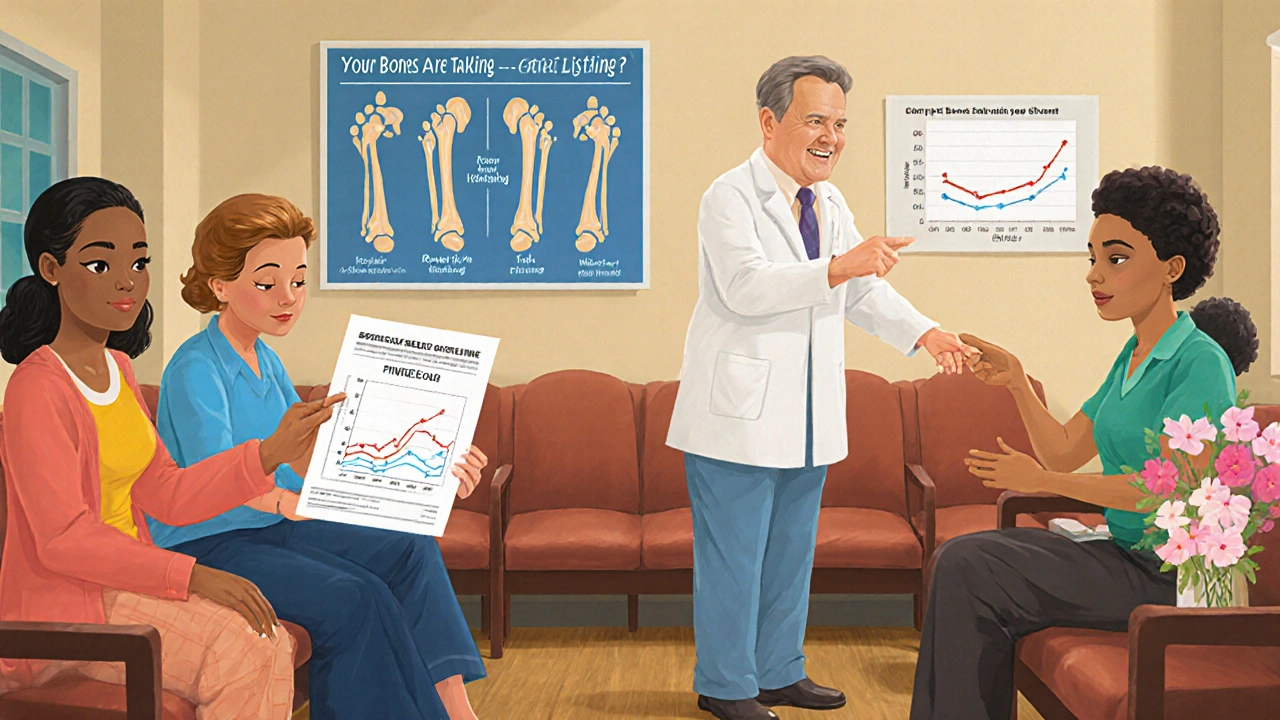Why Bone Turnover Markers Matter in Osteoporosis Treatment
When you start treatment for osteoporosis, you want to know if it’s working. Waiting a year or two for a DXA scan to show if your bone density improved feels like guessing. That’s where bone turnover markers come in. These are proteins and fragments in your blood that tell you how fast your bones are breaking down and rebuilding. Unlike DXA scans, which measure density, bone turnover markers show you what’s happening at the cellular level-right now.
Think of it like checking your car’s engine light. You don’t wait for the engine to fail before you act. Bone turnover markers do the same for your skeleton. If your treatment is working, these markers shift quickly-within weeks. If they don’t, you might be taking medication that’s not helping, or worse, you’re not taking it at all.
The Two Gold Standard Markers: PINP and β-CTX-I
Not all bone markers are created equal. The International Osteoporosis Foundation and European Calcified Tissue Society settled on two as the most reliable: serum PINP (procollagen type I N-terminal propeptide) and plasma β-CTX-I (beta-isomerized C-terminal telopeptide of type I collagen).
PINP is a formation marker. It rises when new bone is being made. β-CTX-I is a resorption marker. It goes up when old bone is being broken down. Together, they give you a full picture of bone remodeling.
These markers are measured with automated blood tests, not urine samples. That’s important. Blood tests are more consistent, easier for patients, and less affected by daily habits like hydration or timing of meals. PINP is stable through the day, but β-CTX-I is sensitive to when you last ate. That’s why it must be drawn in the morning after an overnight fast.
How Soon Can You Tell If Treatment Is Working?
DXA scans take 12 to 24 months to show meaningful changes in bone density. That’s too long to wait if you’re unsure whether your medication is helping.
With bone turnover markers, you get answers in 3 to 6 weeks. For antiresorptive drugs like bisphosphonates or denosumab, β-CTX-I should drop by at least 30% within 3 months. If it doesn’t, your body isn’t responding. It could mean poor adherence, wrong dosage, or another underlying issue.
For anabolic drugs like teriparatide, the opposite happens. PINP spikes-often doubling or tripling within 1 to 3 months. That’s a good sign. It means your bones are actively building new tissue.
The TRIO study showed patients who hit a 30% drop in β-CTX-I at 3 months had a 1.6% lower fracture risk after just 22 weeks. That’s a direct link between early marker changes and real-world outcomes.
What If Your Markers Don’t Change?
If your PINP or β-CTX-I levels don’t move after 3 months, something’s off. The most common reason? You’re not taking your medication as prescribed. Studies show bone turnover markers can spot non-adherence with 85% accuracy. That’s better than asking patients if they remember to take their pills.
Other reasons include poor absorption (especially with oral bisphosphonates), kidney problems, or even undiagnosed secondary causes like hyperparathyroidism. In those cases, your doctor may need to adjust your treatment or run more tests.
For people with chronic kidney disease, standard markers like PINP and β-CTX-I can be misleading because the kidneys clear them slowly. In those cases, bone alkaline phosphatase (BALP) or TRACP5b are better options. The key is matching the marker to the patient’s health profile.

How to Get Accurate Results
These tests are powerful-but only if done right. A single mistake in how the sample is collected can throw off results by 40%.
- Fast overnight for β-CTX-I. No food, coffee, or even water after midnight.
- Collect between 8 and 10 a.m. CTX levels rise after eating and drop at night. Morning is the only consistent window.
- Same lab, same method for follow-up tests. Different machines give different numbers. Consistency matters more than absolute values.
- Don’t test right after a fracture or major surgery. Bone turnover spikes naturally during healing.
Even small things matter. If you drink a protein shake or eat a big meal the night before, β-CTX-I can jump 20-30%. That’s not your treatment failing-it’s your breakfast.
How This Fits With DXA Scans
Bone turnover markers don’t replace DXA scans. They complement them.
DXA tells you how dense your bones are. That’s the end result. Bone turnover markers tell you if your treatment is changing how your bones are being rebuilt. That’s the process.
The best approach? Test your baseline markers before starting treatment. Then retest at 3 months. If the numbers move the right way, you’re on track. Wait until 12 to 24 months to do your next DXA scan. That’s when you’ll see the density changes confirmed.
Think of it like checking your weight and your diet logs. The scale tells you if you lost weight. The food diary tells you why.
Who Should Get Tested?
Not everyone needs bone turnover markers. But they’re especially useful for:
- People starting antiresorptive or anabolic therapy for the first time
- Those who’ve had fractures despite treatment
- Patients with poor adherence or suspected non-compliance
- People with kidney disease or other conditions that affect bone metabolism
- Anyone where treatment decisions are uncertain
For most healthy postmenopausal women on standard therapy, baseline testing isn’t always needed. But if your doctor is unsure whether to continue, stop, or switch meds-markers give clarity.

Cost, Coverage, and Access
In the U.S., Medicare covers PINP (CPT 83970) and β-CTX-I (CPT 83935) for osteoporosis monitoring. Each test costs under $35. Many private insurers follow suit.
Europe has higher adoption-up to 60% in countries following ESCEO guidelines. In the U.S., it’s still around 25-35%, mostly because many doctors aren’t trained to use them. Labs are ready. The knowledge gap is between the lab and the clinic.
Global markets are growing fast. The bone turnover marker industry hit $1.2 billion in 2022 and is expected to grow over 8% yearly through 2030. More labs are switching to automated platforms, making testing faster and more reliable.
What’s Next for Bone Turnover Markers?
Researchers are working on point-of-care tests-like a blood test you can get in your doctor’s office in 15 minutes. That could make monitoring as easy as checking your blood pressure.
There’s also new work to define normal ranges for different ethnic groups. Current reference values are mostly based on white populations. Asian individuals tend to have 15-20% lower β-CTX-I levels. African populations show higher PINP. Without adjusted ranges, we risk misdiagnosing or under-treating.
The American Association of Clinical Endocrinologists is expected to update their guidelines in early 2024 to include formal recommendations for BTM use. That will push more doctors to use them routinely.
Bottom Line: A Simple Tool for Better Outcomes
Bone turnover markers aren’t magic. But they’re one of the clearest, fastest ways to know if your osteoporosis treatment is working. They turn guesswork into data. They help you avoid years of unnecessary pills. They give you and your doctor real-time feedback.
If you’re on osteoporosis medication, ask your doctor: "Can we check my PINP and β-CTX-I at 3 months?" If they say no, ask why. The science is solid. The tools are available. The goal is simple: keep your bones strong, and stop fractures before they happen.






Comments
Erika Hunt
24/Nov/2025I've been on denosumab for 18 months now, and honestly, I wish my doctor had ordered these markers earlier. I was convinced the drug wasn't working because my DXA didn't change much after a year-turns out, my β-CTX-I dropped 42% by month 3. I felt so much more in control knowing the science was working behind the scenes. Also, I didn't realize how much meal timing affects results-I once ate a protein bar at 11 p.m. and my next test looked like a disaster. Never again. And yes, I'm the person who sets three alarms for fasting. 😅
Sharley Agarwal
24/Nov/2025This is why people die from osteoporosis.
Srikanth BH
24/Nov/2025If you're on treatment and haven't asked for these markers yet, please do. It's not about fear-it's about empowerment. I watched my mom go through years of uncertainty until her doctor finally ordered PINP and β-CTX-I. The numbers told us she wasn't absorbing her pills. Switched to IV zoledronic acid. No more fractures. Simple. Powerful. Life-changing.
Shirou Spade
24/Nov/2025It's fascinating how medicine is shifting from static measurements to dynamic processes. DXA is like taking a photo of a river. Bone turnover markers are like measuring the current. We used to think the shape of the riverbank was all that mattered. Now we know it's the flow that prevents erosion. Maybe we're finally learning to treat biology as a system, not a snapshot.
Lisa Odence
24/Nov/2025I just want to say-this is one of the most comprehensive, meticulously researched, and clinically relevant summaries I’ve ever read on bone metabolism. 📊💯 The inclusion of CPT codes, ethnic variability, and adherence data is not just impressive-it’s essential. I’ve shared this with my entire endocrinology team. The fact that Medicare covers both markers at under $35 each? That’s a public health win. We need more of this level of detail in medical education. Also, I’ve started printing this out for my patients. 📄✨
Agastya Shukla
24/Nov/2025The 30% threshold for β-CTX-I suppression is based on the TRIO study’s cohort, but what’s the coefficient of variation for the assay? I’ve seen intra-lab CVs up to 12% even on automated platforms. If a patient’s baseline is 0.4 ng/mL and post-treatment is 0.28 ng/mL, is that a 30% drop or assay noise? We need to define clinical significance thresholds with confidence intervals, not just percentages.
Pallab Dasgupta
24/Nov/2025I’ve been telling my doctor for YEARS that this is the future. Why are we still relying on ancient DXA scans like we’re living in 2005? I got my first PINP test after 3 months on teriparatide-my levels tripled. I cried. Not because I was scared, but because I finally felt like my body was healing, not just surviving. This isn’t just medicine-it’s hope, in a blood tube. If your doc doesn’t get this, find a new one. Period.
Ellen Sales
24/Nov/2025I love how this post ties together science and practicality. I’ve been on alendronate for 5 years. I used to think if I didn’t feel anything, it wasn’t working. Turns out, I was just lucky. My β-CTX-I dropped 38% in 6 weeks. I didn’t feel a thing. But my bones did. And that’s the point. We don’t need to feel the change to know it’s happening. Sometimes, the best healing is the quietest. I’m sharing this with my sister-she’s skeptical about her meds too.
Josh Zubkoff
24/Nov/2025Okay, so we’ve got a 10-page essay on blood tests. Great. But how many people actually get these? Like, 25% in the US? That means 75% of people are flying blind. And why? Because doctors are lazy. Or scared. Or don’t want to explain why their patient’s ‘normal’ lab results are actually abnormal. This isn’t science-it’s a systemic failure wrapped in jargon. And now we’re supposed to be impressed? Please. If this were truly standard of care, it’d be in every primary care office. It’s not. So it’s not important. It’s just a fancy diagnostic luxury.
fiona collins
24/Nov/2025Thank you for highlighting ethnic variability. I’m Māori and always felt my results were ‘off’-turns out, the reference ranges weren’t built for us. This matters.
Rachel Villegas
24/Nov/2025I just started denosumab last month. My doctor said to wait a year for the DXA. I asked about the markers. She looked confused. I printed this out and gave it to her. She said she’d look into it. I’m hopeful.